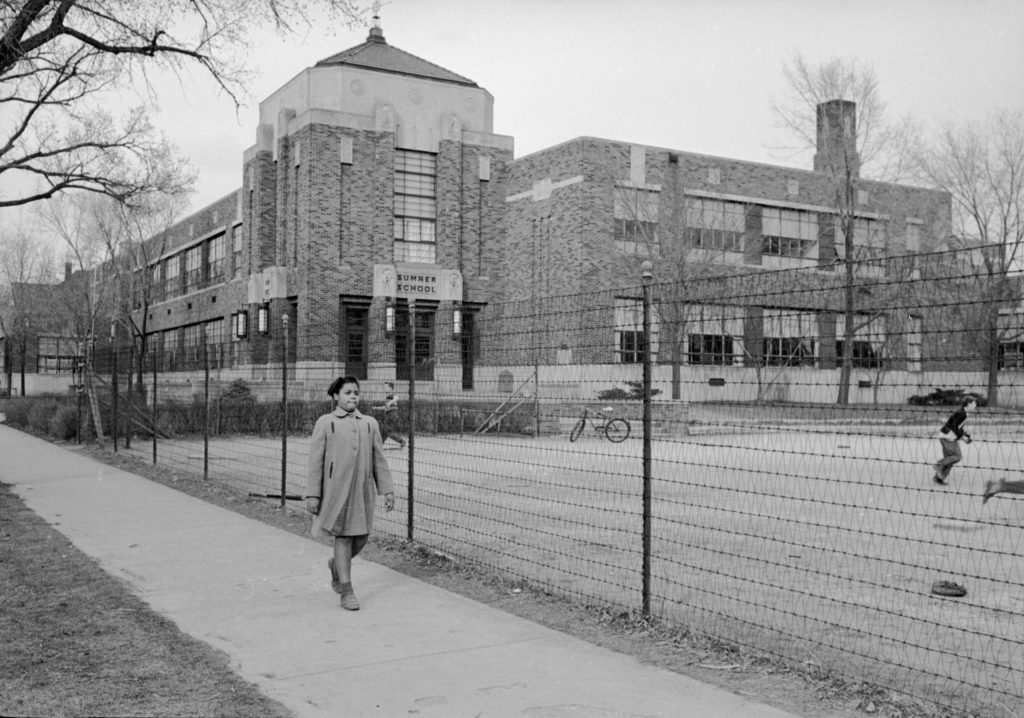Images depicting these events may contain themes or terms that do not reflect current acceptable language. The Hechinger Report edited the original captions for clarity and style.
1954: The Supreme Court rules that state-sanctioned segregation of public schools violates the 14th Amendment in Brown v. The Board of Education of Topeka, Kansas. The decision overturns the Court’s 1896 decision in Plessy v. Ferguson, which stated “separate but equal” facilities were constitutional.
Brown v. Board of Education consolidates lawsuits filed in Delaware, the District of Columbia, Kansas, South Carolina and Virginia in response to school segregation. Credit: National Archives Foundation
The auditorium of Morton High school (left) a school for Black students and the auditorium of Farmville High School (right) a school for white students. These images were filed as evidence by the plaintiffs of Dorothy E. Davis, et al. v. County School Board of Prince Edward County, Virginia, one of the cases consolidated with Brown v. Board of Education. Credit: National Archives Foundation
1955: A year after the Supreme Court’s Brown I decision that segregated schools are inherently unequal, little had changed. In Brown II, the court considered how its decision should be implemented. It did not set a deadline for schools to desegregate, requiring only that they do so “with all deliberate speed.”
Credit: Underwood Archives/Getty Images
Students chat while waiting for a history lesson to begin at Oak Ridge High School in Oak Ridge, Tennessee, on Sept. 20, 1955. Previously an all-white institution, the school was desegregated by order of the Atomic Energy Commission, which administered the affairs of the community. Credit: Photo by Underwood Archives/Getty Images
1956: The University of Alabama admits Autherine Lucy, its first Black student. She was met with violence from white supremacist groups and widespread protests from white students.
University of Alabama students demonstrate on the Tuscaloosa campus following the recent admittance of its first Black student, Autherine Lucy. The demonstration drew hundreds of participants. Credit: Bettmann via Getty Images
Autherine Lucy, center, the first Black student to attend the University of Alabama, discusses her return to campus following mob demonstrations in Birmingham, Ala., on Feb. 7, 1956. Credit: Gene Herrick/Associated Press
1957: Federal and state powers clash over the admittance of nine black students to Little Rock Central High in Little Rock, Arkansas.
Arkansas National Guardsmen Carl Cobb, left, and D.D. Evans, right, stand guard at one of the entrances to Central High School in Little Rock, Ark. Gov. Orval Faubus’ activation of the troops led the school board to postpone scheduled racial integration on Sept. 3, 1957. Credit: Associated Press
Elizabeth Eckford, center, ignores the hostile screams and stares of fellow students on her first day of school, Sept. 6, 1957. She was one of the nine Black students whose admission to Central High School in Little Rock, Ark., was ordered by a federal court following legal action by the NAACP. Credit: Bettmann via Getty Images
1958: Thousands of young people take part in the “Youth March for Integrated Schools” in Washington, D.C.
Credit: Getty Images
More than 15,000 people – white and Black – march down Madison Drive to the Washington Monument, as part of an NAACP rally calling for the integration of schools, in Washington, D.C. Credit: Getty Images
A crowd outside the state capitol in Little Rock, Ark., protests the integration of Central High School on Aug. 20, 1959. Credit: Circa Images/GHI/Universal History Archive/Universal Images Group via Getty Images
1960: First graders Ruby Bridges, Gail St. Etienne, Leona Tate and Tessie Prevost integrate schools in New Orleans.
Deputy U.S. marshals escort Ruby Bridges, 6, from William Frantz Elementary School in New Orleans on Nov. 14, 1960. The first grader was the only Black child enrolled in the school. The parents of white students boycotted the court-ordered integration and took their children out of school. Credit: Associated Press
Lee Hooks and other white housewives demonstrate against planned desegregation at William Frantz Elementary School in New Orleans on Dec. 2, 1960. Credit: Bettmann via Getty Images
1961-1963: Attempts to integrate Southern colleges by federal order are met with riots and violence.
Black students Charlayne Hunter, center, and Hamilton Holmes, right, after being suspended from the University of Georgia. Credit: Donald Uhrbrock/Getty Images
Rioters stand outside the University of Georgia the day Charlayne Hunter and Hamilton Holmes integrated the university. Hunter was evacuated from her Myers Hall dormitory to Atlanta after police used tear gas to disperse rioting students on Jan. 11, 1961. Credit: Bettmann via Getty Images
Gov. George Wallace attempts to block integration at the University of Alabama. He is confronted by Deputy U.S. Attorney General Nicholas Katzenbach. Credit: Buyenlarge/Getty Images
Credit: OFF/AFP via Getty Images
Vivian Malone and James Hood, two Black students, register at the University of Alabama on June 12, 1963, in Tuscaloosa, Ala., after a federal court barred state government interference with their enrollment. Despite this order, Gov. George Wallace appointed himself the temporary university registrar and stood in the doorway of the administration building to prevent the students from registering. In response, President John F. Kennedy federalized the Alabama National Guard. Some 100 guardsmen escorted the students to campus. The guards’ commander, Gen. Henry Graham, ordered Wallace to “step aside.” Credit: OFF/AFP via Getty Images
1964: The Civil Rights Act of 1964 is passed. The law, which prohibits discrimination based on race, color, religion, sex or national origin, includes clauses outlawing segregation and denying federal funds to schools and academic programs that discriminate.
President Lyndon B. Johnson shakes the hand of Dr. Martin Luther King, Jr. at the signing of the Civil Rights Act while officials look on in Washington, D.C. Credit: Photo by Hulton Archive/Getty Images
People protesting integration carry placards reading “Kill the Bill” and “Vote for Wallace,” in support of Alabama Gov. George Wallace in 1964. Wallace was a proponent of segregation and strongly opposed the Civil Rights Act of 1964, which outlawed racial discrimination. Credit: FPG/Archive Photos/Getty Images
1971: In Swann v. Charlotte-Mecklenburg Board of Education, the Supreme Court approves busing, magnet schools and compensatory education as acceptable tools to speed up the process of integration.
Credit: Associated Press
Police escort school buses on Sept. 16, 1974, from the Gavin School in South Boston on the third day of court-ordered busing to integrate Boston’s public schools. Credit: Associated Press
Chinatown residents protest against integration in favor of neighborhood schools at a San Francisco school board meeting about busing on June 12, 1974. Credit: Vince Maggiora/San Francisco Chronicle via Getty Images
1978: The Supreme Court rules in favor of Allan Bakke, a white student who alleges he was discriminated against, in Regents of the University of California v. Bakke.
Allan Bakke is trailed by news and television reporters after attending his first day at the Medical School of the University of California, Davis, on Sept. 25, 1978. Bakke sued the university for reverse discrimination after his applications were rejected in 1973 and 1974. The Supreme Court ordered the university to admit Bakke, deciding that the school had illegally discriminated against him because he is white. Credit: Associated Press/Walt Zeboski
2003: The Supreme Court rules in favor of affirmative action in college admissions with its decision in Grutter v. Bollinger.
Supporters of affirmative action, Candyce Phoenix, 18, left, and Aaron Nelson, 20, from Washington, D.C., rally in front of the Supreme Court after the ruling in Grutter v. Bollinger, which allowed the use of affirmative action in college admissions on June 23, 2003. Credit: Associated Press/Charles Dharapak
2023: The Supreme Court rules that the consideration of race in college admissions is unconstitutional, adjudicating two cases simultaneously: Students for Fair Admissions v. The University of North Carolina and Students for Fair Admissions v. President & Fellows of Harvard College.
People with the Asian American Coalition for Education rally outside the Supreme Court on June 29, 2023, in Washington, D.C. In a 6-3 vote, the court ruled that race-conscious admissions programs at Harvard and the University of North Carolina were unconstitutional, establishing a new precedent that could end affirmative action in college admissions at schools that receive federal funding. Credit: Kent Nishimura/Los Angeles Times via Getty Images
Kashish Bastola, a rising sophomore at Harvard, hugs Nahla Owens, a fellow Harvard student, outside the Supreme Court on June 29, 2023, in Washington, D.C. Credit: Kent Nishimura/Los Angeles Times via Getty Images
This story about school segregation was produced by The Hechinger Report, a nonprofit, independent news organization focused on inequality and innovation in education. Sign up for the Hechinger newsletter.
The post School Segregation: A visual timeline appeared first on The Hechinger Report.
Images depicting these events may contain themes or terms that do not reflect current acceptable language. The Hechinger Report edited the original captions for clarity and style. 1954: The Supreme Court rules that state-sanctioned segregation of public schools violates the 14th Amendment in Brown v. The Board of Education of Topeka, Kansas. The decision overturns
The post School Segregation: A visual timeline appeared first on The Hechinger Report. Elementary to High School, Featured Stories, News, Race and Equity, Special Reports, Brown vs Board of Education The Hechinger Report










